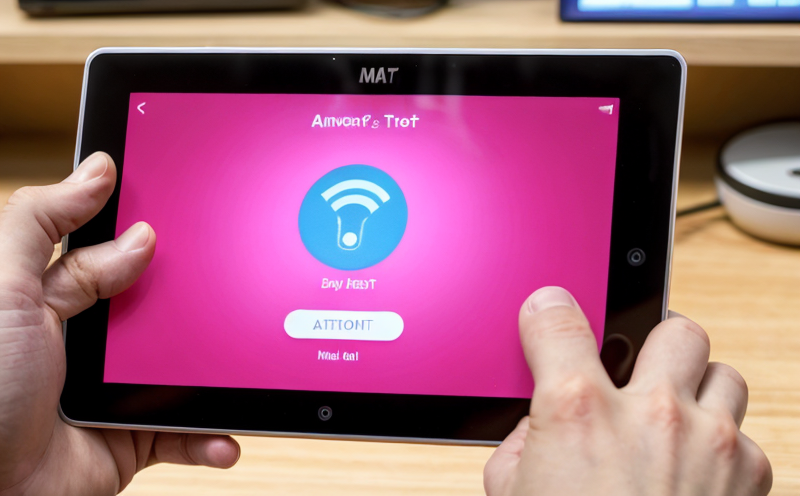Cybersecurity Vulnerability Testing in Smart Devices
As technology advances, smart devices have become an integral part of modern consumer products. These devices are not only convenient but also increasingly interconnected through the Internet of Things (IoT). However, with this connectivity comes a new set of challenges—namely, cybersecurity risks. In this section, we will delve into the critical importance of Cybersecurity Vulnerability Testing in Smart Devices and how it ensures consumer safety while maintaining product integrity.
The rise of smart devices has led to an increase in potential vulnerabilities that cybercriminals can exploit. These vulnerabilities can range from software bugs to insecure communication protocols, making the need for thorough testing more pressing than ever. Security breaches not only compromise user data but also erode trust in the brand and product line.
Cybersecurity Vulnerability Testing involves identifying potential weaknesses within a smart device's hardware or software that could be exploited by malicious actors. This process typically includes static analysis, dynamic analysis, penetration testing, and vulnerability scanning. Static analysis examines the code without executing it to find known vulnerabilities or coding errors. Dynamic analysis monitors the behavior of the device during operation.
Penetration testing simulates real-world attacks using actual exploits to evaluate security defenses. Vulnerability scanning tools automatically detect potential weaknesses in the system, providing a detailed report on areas that require attention. By conducting these tests, manufacturers can identify and mitigate risks before they are exploited by malicious actors.
The process of cybersecurity vulnerability testing is crucial for ensuring compliance with international standards such as ISO/IEC 27034-1:2018, which provides guidelines for information security management systems (ISMS) in the context of smart devices. Additionally, adherence to industry-specific requirements like those found in the Consumer Product Safety Improvement Act (CPSC) helps protect consumers from potential hazards.
Properly conducted testing ensures that smart devices meet rigorous safety and security standards. It is essential for maintaining consumer trust and protecting both brand reputation and legal compliance. Failure to address these issues can result in costly recalls, damaged reputations, and even legal action under regulations like the GDPR or CCPA.
Applied Standards
In order to ensure that smart devices are secure against cyber threats, adherence to specific international standards is crucial. Some key standards include:
- ISO/IEC 27034-1:2018 – Information security management systems for information security in the context of smart devices.
- EN 30528 (IoT Security) – Provides general requirements and recommendations for enhancing the security of IoT products, including smart devices.
These standards provide a framework for developing secure smart devices by addressing various aspects such as secure boot processes, encryption methods, access control mechanisms, and data protection techniques. By following these guidelines, manufacturers can significantly reduce the risk of vulnerabilities being exploited.
International Acceptance and Recognition
The importance of cybersecurity vulnerability testing in smart devices is widely recognized across different regions around the world. Many countries have implemented regulations to ensure that smart products meet certain security criteria before they can be sold domestically or exported internationally.
In Europe, the General Data Protection Regulation (GDPR) requires businesses handling personal data to implement appropriate technical and organizational measures to protect such information. This includes ensuring secure communication channels between devices within an IoT network. Similarly, in North America, organizations must comply with regulations set forth by agencies like the Federal Trade Commission (FTC) regarding fair practices around privacy policies.
Compliance with these international standards not only helps companies avoid legal penalties but also enhances their ability to compete globally. Adhering to recognized frameworks demonstrates a commitment to quality and safety, which is increasingly valued by consumers who are becoming more aware of the risks associated with connected devices.
Use Cases and Application Examples
- Homes & Smart Homes: Security systems that connect to a central hub via Wi-Fi or Bluetooth are susceptible to hacking attempts. Regular vulnerability assessments help keep these systems safe.
- Healthcare Devices: Wearables like fitness trackers and medical monitoring devices must maintain patient data security while ensuring accurate readings. Testing ensures both privacy protection and reliable performance.
- Automotive Electronics: Modern vehicles contain numerous electronic components that communicate wirelessly, making them prime targets for hackers. Ongoing testing helps prevent unauthorized access to sensitive vehicle functions.
In each of these scenarios, thorough cybersecurity vulnerability testing plays a vital role in safeguarding against potential threats while maintaining optimal functionality. This ensures that users can enjoy the benefits of advanced technology without worrying about security breaches.





